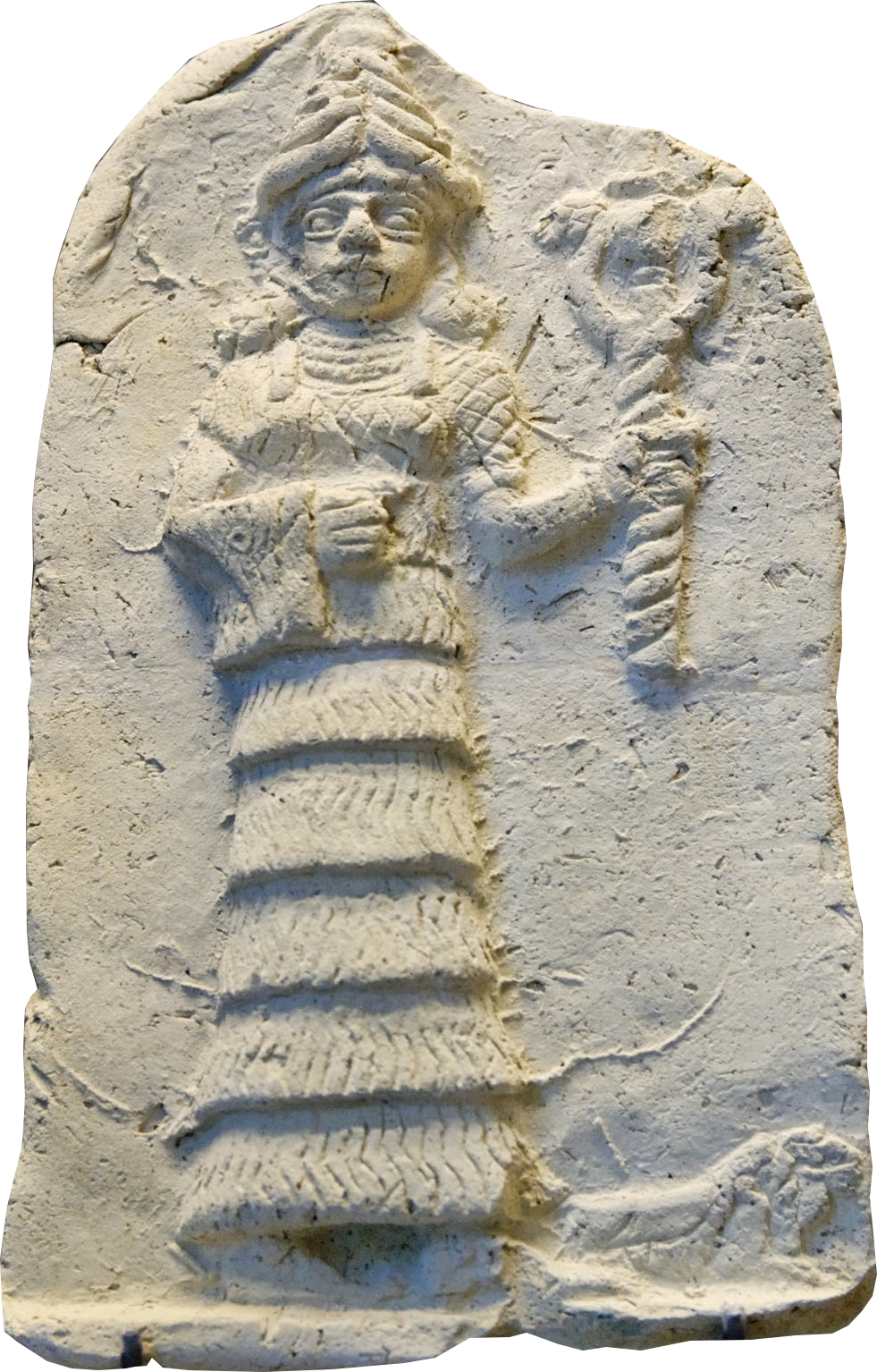Ancient Psychedelia: Alien Gods & Mushroom Goddesses
Online Book - Chapter 8, Page 116
Back to Online Book Mainpage / Next Page (Chapter 8, Page 117)
 (13f) Inanna From Eshnunna Louvre Museum c. 2000-1000 BC In some texts she is referred to as the “Cow of the moon god Sin.” In her name Usunzianna, she is the “Exalted Cow of Heaven.” As Nin.an.na, she was the “queen of the sky.” (72) In the Hymn of Inanna and Iddin-Dagan, she is called “the good wild cow of An.” According to E.O. James, she was “the embodiment of the creative powers of spring and the personification of the autumnal decline in the seasonal cycle.” (73) Inanna’s relation to Dumuzi was the same as Ishtar’s to Tammuz. In ancient Babylon through the time of the 18th to the 7th century BC, the goddess was the central figure of worship and devotion as this prayer to Ishtar attests: “Unto Her who renders decisions, Goddess of all things, Unto the Lady of Heaven and Earth who receives supplication; Unto Her who hears petition, who entertains prayer; Unto the compassionate Goddess who loves righteousness; Ishtar the Queen, who suppresses all that is confused. To the Queen of Heaven, the Goddess of the Universe, the One who walked in terrible Chaos and brought life by the Law of Love; And out of Chaos brought us harmony, and from Chaos Thou has led us by the hand.” – Babylon, Eighteenth to Seventh Centuries BC (74) It becomes very apparent after reading hymns like this that goddess worship was not initially suppressed in the time when Patriarchy was first building momentum under an astrological pantheon, and this was the beginning of concepts of lunar and solar worship along with deities being associated with them. Prior to this, the only deities appear to be mushroom deities brought about by earth elements associated with wind, rain, storms, fire, heaven and earth. There does not appear to be a real ancient history to solar or lunar deities, and this is reflected in the lack of symbolism in the imagery. Everything attributable to the sun or moon, we can clearly see, belongs to the cow and bull deities. In the hymn Inanna and Iddin-Dagan (Iddin-Dagan A), the sacred marriage is the theme of the entire story and Inanna is the main character: “ … When at evening, the radiant star, the Venus star, the great light which fills the holy heavens, |
the lady of the evening, ascends above like a warrior, the people in all the lands lift their gaze to her…. They purify the earth for the Mistress, they carry out purification rites for her…They fill the tables of the Land with ghee, dates, cheese, and seven sorts of fruits as first-fruit offerings for her. They pour dark beer for her, they pour light beer for her… The divine king stays there with her… Esparto grass is purified with cedar perfume and arranged on that bed for my lady… In order to find sweetness in the bed on the joyous coverlet, my lady bathes her holy thighs. She bathes them for the thighs of the king; … The king goes to her holy thighs with head held high…after holy Inanna has made him rejoice with her holy thighs on the bed, she relaxes with him on her bed: "Iddin-Dagan, you are indeed my beloved!” “…The palace is in festive mood, the king is joyous. The people spend the day amid plenteousness… They praise my lady on my behalf with the hymns of heaven and earth. “You are the Mistress born together with heaven and earth.” (75) This hymn clearly represents the marriage of heaven and earth, with the earth being represented by the earthly king who is married to the Queen of Heaven, in this case, Inanna. In The Courtship of Inanna and Dumuzi, another sacred marriage hymn, Inanna is being wed to Dumuzzi and it begins with her brother, Utu, the Sun god in conversation with Inanna: “The brother spoke to his younger sister. The Sun God, Utu, spoke to Inanna, saying: ‘Young Lady, the flax in its fullness is lovely. Inanna, the grain is glistening in the furrow. I will hoe it for you. I will bring it to you....’ After a number of back and forth discussions about who will comb it, spin it, braid it, and weave it they get to the discussion of who will bed Inanna. ...Inanna: ‘Brother, after you’ve brought my bridal sheet to me, Who will go to bed with me? Utu, who will go to bed with me?’ Utu responds: ‘Sister, your bridegroom will go to bed with you. He who was born from a fertile womb, He who was conceived on the sacred marriage throne, Dumuzi, the shepherd! He will go to bed with you.’ After some protestation and desire to wed the farmer instead, her mother Ningal helped confirm that indeed Dumuzi would be the best husband for her, she readies herself for him with oils and perfume and lapis beads and they embrace and kiss. Then Inanna asks Dumuzi … ‘My vulva, the horn, The Boat of Heaven, Is full of eagerness like the young moon. My untilled land lies fallow. As for me, Inanna, Who will plow my vulva? Who will plow my high field? Who will plow my wet ground?’ Dumuzi responds that he will do all this.” (72) The Hebrew Goddess, Raphael Patai, Wayne State University Press, 1990 (Originally Published 1967), p. 136-7; https://inanna.virtualave.net/inanna.html (73) Cult of the Mother Goddess, p. 50 (74) When God was a Woman (75) http://etcsl.orinst.ox.ac.uk/section2/tr2531.htm |
Go Back to Page 115